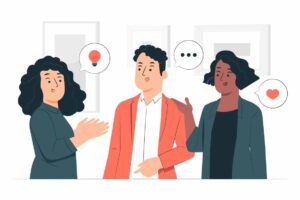Facial expressions, body language, eye contact, and tone of voice are important elements for building solid connections. They’re all part of nonverbal communication; when you use them well, you can connect with your team and customers on a whole new level.
Whether you aim to tighten bonds within your organization or amp up customer satisfaction, this article dives into the world of nonverbal communication, giving you some critical insights into how it can work wonders for you in the workplace.
What Is Nonverbal Communication?
Nonverbal communication is conveying messages or information without the use of spoken words. Also called manual language, it refers to the ability to communicate without using oral or written words. This kind of communication is key to successful interactions at work, relying on managers and teams adept at using and interpreting body language.
The Significance of Nonverbal Communication in Business
As some of the best associate degrees in 2024 would teach you, nonverbal communication—hand signals, gestures, and posture—can significantly help amplify verbal messages. This is especially true within the workplace.
For example, a manager communicating positive nonverbal cues when speaking with employees can help increase employee morale, improving job performance as well. While your team tunes in to whatever you’re saying, nonverbal cues significantly influence how your message is perceived.
Also, positive nonverbal cues can empower a business owner to boost customer sales, particularly when utilizing them during negotiations. If you’ve ever recorded your video meetings with clients or partners, you’ll notice this right away. That’s why smiling, making eye contact, and having a relaxed posture can really help you make a great impression and boost your chances of closing the deal.
Also, incorporating emotional cues related to ‘emotion in sales’, such as understanding and empathizing with the client’s needs, can ultimately enhance your communication and connection, leading to more successful outcomes.
In the following sections, we’ll dig deeper into examples of nonverbal communication and how you can best utilize them in the workplace.
1/ Gestures:
Gestures can be easy, quick, and efficient in face-to-face communication. A simple hand wave means hello or goodbye, depending on the situation. A simple nod or shake means you have already communicated a yes or a no.
By displaying positive gestures in the workplace, you become more approachable and easily forge stronger connections with others around you. Your body language ultimately shows the kind of person that you are. Hence, to make a favorable impression, exhibiting positive gestures is crucial. These can be indicators of your enthusiasm, attitude, and personality.
2/ Eye Contact:
Another key part of nonverbal communication is eye contact. It can really improve how you interact with others. Eye contact helps you build trust, show emotions, and connect with people, which is super important in both personal and professional relationships.
Being good at making eye contact helps you stay focused and confident when you’re talking or presenting. When you keep eye contact with someone, it means you’re both engaged in the conversation and they’re really paying attention to what you’re saying. Plus, it makes you seem more authoritative and empathetic.
3/ Body Language and Posture:
A good posture can convey information regarding interpersonal relationships and personality traits like confidence, submissiveness, and openness.
If you want to master body language, start by practicing sitting straight when talking to others. This way, you can look more attentive and confident. Moreover, it can evoke a sense of interest, enhance professionalism in appearance, and promote greater engagement and focus during meetings. Adopting an open posture, whether standing or sitting, communicates confidence and can help you demonstrate it to those around you.
4/ Personal Space:
Maintaining personal space in work interactions demonstrates professionalism and respect. It accommodates a person’s space without making them think that you’re getting way too close or invading their privacy. Letting others have their personal space fosters a sense of safety and comfort, enabling them to work more freely.
5/ Facial Expressions:
Using facial expressions as a form of nonverbal communication can demonstrate attentiveness, especially during workplace meetings or when speaking to colleagues. Your reactions and emotions can be conveyed by showing a slight smile, nodding occasionally, and maintaining good eye contact.
People always pick up on your nonverbal cues, especially your facial expressions. Whether you’re meeting in person or on a virtual call, your face says a lot about what you’re thinking and feeling. Interestingly, only 7% of communication is about the words we use. The tone of your voice makes up 38%, and body language accounts for the remaining 55%.
6/ Appearance and Dress:
Personality and behavior are not the only things necessary in the workplace—89% say appearances also matter. How you dress for the workplace shows professionalism, letting others know you take your job seriously.
7/ Touch:
Think of touch as a universal language for emotions. Whether it’s a friendly pat on the back, a solid handshake, or a gentle arm squeeze, it’s all about conveying warmth and connection. But hey, remember to respect people’s personal space and cultural differences, alright?
8/ Tone of Voice:
Ever notice how someone talking can change the mood of people listening to the conversation? How you say the things that you want to say, including the pitch, volume, and speed, can affect the meaning of your message, so you’ve got to be careful. You don’t want to be misinterpreted. A chill, friendly tone can make you seem approachable and understanding while sounding like a robot or a grump might put people off.
9/ Eyebrow Movements:
Believe it or not, your eyebrows can speak volumes, too. They can express everything from surprise to concern with just a wiggle. Pay attention to those subtle brow movements – they can easily convey your feelings.
The Role of Technology in Nonverbal Communication
Technology has changed how we communicate without words, transforming the way we express ourselves and understand others. Here’s how tech shakes up nonverbal communication:
- Emojis and emoticons. These little graphics let us show our feelings and vibes while typing away. They fill in for our facial expressions and gestures in face-to-face chats.
- Video calls. Platforms like Zoom and Skype bring us face-to-face, even miles apart. We can catch each other’s expressions and body language, though it’s not quite like being there in person.
- Virtual reality (VR). VR puts us in crazy situations where we can act and react like real life. It’s all about gestures, movements, and expressions, making nonverbal stuff feel legit.
- Augmented reality (AR). AR opens up new ways to say stuff without words. Think Snapchat filters are giving us incredible ways to express ourselves.
- Chatbots and virtual helpers. Even though they’re not real people, chatbots and virtual assistants try to sound human. They use tone, timing, and sometimes visual communication to connect with us emotionally.
- Online avatars. In gaming worlds, we make these virtual versions of ourselves. They can show our moods with facial expressions and gestures, bringing nonverbal vibes to the digital realm.
- Social media. Reactions, stickers, and gifs on platforms like Facebook and Twitter add extra layers to our online convos. They help us express feelings and emotions in a fun way.
Nonverbal Communication in the Workplace
In the workplace, it’s crucial to showcase your skills, experience, and qualifications, but don’t overlook the significance of nonverbal communication.
How you react, move, and stand says a lot about how you receive the messages and ideas being presented and how you deliver it. Your gestures and expressions also say a lot, helping you improve and pave the way for effective communication.



